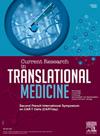DNMT3A-related overgrowth syndrome presenting with immune thrombocytopenic purpura
IF 3.2
4区 医学
Q2 MEDICINE, RESEARCH & EXPERIMENTAL
引用次数: 0
Abstract
Tatton-Brown-Rahman syndrome (TBRS) is characterized by overgrowth, cognitive deficiency, and distinctive facial features resulting from germline DNMT3A variants. This report describes a four-year-old female diagnosed with TBRS due to a de novo and novel heterozygous DNMT3A variant, NM_022552.5:c.1627G>C:p.(Gly543Arg). Alongside typical TBRS features, she had a history of hospitalization for immune thrombocytopenic purpura (ITP) at five months old. While ITP is clinically diagnosed and has multifactorial origins, studies have demonstrated its autoimmune and genetic components. DNMT3A protein, responsible for DNA methylation, regulates various cellular processes, including hematopoiesis and autoimmunity. It has been reported that ITP patients exhibit decreased expression of DNMT3A, and specific variants linked to decreased platelet counts have been identified in a murine model for TBRS. Additionally, some case reports have been described with multiple cytopenias and thrombocytopenia without hematologic malignancy. In conclusion, this report emphasizes for the first time the occurrence of ITP in a TBRS patient and suggests that autoimmune and hematologic disorders may need to be considered in the follow-up of these patients. However, further evidence is required to establish a direct correlation.
出现免疫性血小板减少性紫癜的 DNMT3A 相关生长过度综合征。
塔顿-布朗-拉赫曼综合征(TBRS)的特征是生殖系 DNMT3A 变异导致的发育过度、认知缺陷和独特的面部特征。本报告描述了一名四岁女性因一个新的杂合子 DNMT3A 变异 NM_022552.5:c.1627G>C:p.(Gly543Arg)而被诊断为 TBRS。除了典型的 TBRS 特征外,她在五个月大时还曾因免疫性血小板减少性紫癜(ITP)住院治疗。虽然免疫性血小板减少性紫癜是临床诊断出来的,并且有多因素的起源,但研究已经证明了它的自身免疫和遗传因素。DNMT3A 蛋白负责 DNA 甲基化,调节各种细胞过程,包括造血和自身免疫。据报道,ITP 患者表现出 DNMT3A 表达减少,而且在 TBRS 的小鼠模型中发现了与血小板计数减少有关的特定变体。此外,在一些病例报告中还描述了多种细胞减少症和血小板减少症,但没有血液恶性肿瘤。总之,本报告首次强调了 TBRS 患者发生 ITP 的情况,并提示在对这些患者进行随访时可能需要考虑自身免疫和血液系统疾病。然而,要建立直接的相关性还需要进一步的证据。
本文章由计算机程序翻译,如有差异,请以英文原文为准。
求助全文
约1分钟内获得全文
求助全文
来源期刊

Current Research in Translational Medicine
Biochemistry, Genetics and Molecular Biology-General Biochemistry,Genetics and Molecular Biology
CiteScore
7.00
自引率
4.90%
发文量
51
审稿时长
45 days
期刊介绍:
Current Research in Translational Medicine is a peer-reviewed journal, publishing worldwide clinical and basic research in the field of hematology, immunology, infectiology, hematopoietic cell transplantation, and cellular and gene therapy. The journal considers for publication English-language editorials, original articles, reviews, and short reports including case-reports. Contributions are intended to draw attention to experimental medicine and translational research. Current Research in Translational Medicine periodically publishes thematic issues and is indexed in all major international databases (2017 Impact Factor is 1.9).
Core areas covered in Current Research in Translational Medicine are:
Hematology,
Immunology,
Infectiology,
Hematopoietic,
Cell Transplantation,
Cellular and Gene Therapy.
 求助内容:
求助内容: 应助结果提醒方式:
应助结果提醒方式:


